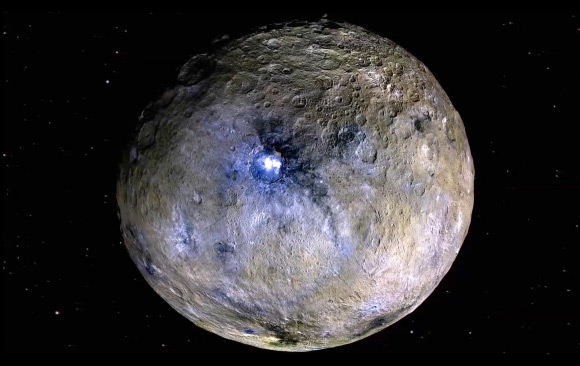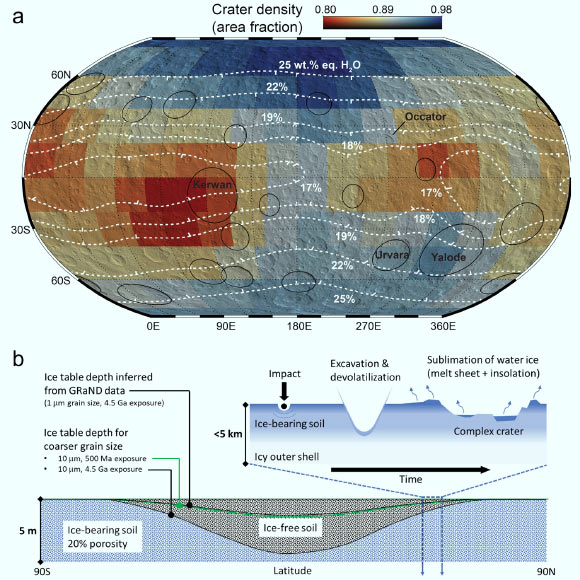Using high spatial-resolution data gathered by the Gamma Ray and Neutron Detector (GRaND) aboard NASA’s Dawn spacecraft, planetary researchers have detected elevated concentrations of hydrogen in and around Occator crater, which contains Ceres’ most prominent bright spots.

This false-color image shows the dwarf planet Ceres. Image credit: NASA / JPL-Caltech / UCLA / MPS / DLR / IDA.
“The dwarf planet Ceres, the largest body in the main asteroid belt, is water-rich,” said Dr. Tom Prettyman, a senior scientist at the Planetary Science Institute, and his colleagues.
“Ceres’ average interior structure consists of a rocky mantle and a 40-km- (25-mile) thick crust, dominated by the frozen remnants of an ancient, global ocean.”
“Rheological constraints indicate that the crust is volatile-rich, containing water ice, phyllosilicates, salts, and possibly clathrate hydrates.”
“The outermost meter of Ceres contains water ice that is gradually sublimating in response to heating of the surface by sunlight,” they said.
“Since Ceres’ axis of rotation is nearly perpendicular to the Sun’s rays, ice has receded to greater depths at the equator than the poles.”
“We hypothesized that impacts can bring water ice from the outer crust to the surface, replenishing the regolith with ice,” they added.
“As such, the distribution of near surface water ice in the upper few decimeters of the regolith as sensed by GRaND is shaped both by large impacts and long-term insolation-driven sublimation.”
“We tested this hypothesis with high-spatial-resolution GRaND data acquired in Dawn’s final mission phase.”

Impact processes as a partial control on the global distribution of hydrogen on Ceres: (a) a map of the density of large craters is compared to the global distribution of hydrogen measured by the Gamma Ray and Neutron Detector (GRaND) (white contours); a density of one indicates craters fully cover the surface within GRaND’s field of view; for context, the map is superimposed on shaded relief and excluded basins with diameters greater than 100 km (62 miles) are outlined (black); (b) a possible scenario for enrichment of surficial ice by large impacts is illustrated; a portion of the ice excavated from the crust survives during crater formation and cooling of the melt sheet and ejecta blanket, enriching the regolith in water ice; the surviving ice retreats in response to solar insolation. Image credit: Prettyman et al., doi: 10.1029/2021GL094223.
The GRaND neutron spectrometer detected elevated hydrogen concentrations in the outermost meter of the surface of Occator, a young, 90-km- (56-mile) diameter, complex crater located at 19.82 °N where near-surface ice is not expected.
“The excess hydrogen is in the form of water ice,” the researchers said.
“The results confirm Ceres outer crust is ice rich and that water ice can survive within impact ejecta on airless, icy bodies.”
The data imply partial control of the distribution of near-surface ice by large impacts and provide constraints on surface age and regolith thermophysical properties.
“We think that ice has survived in the shallow subsurface during the roughly 20 million years following the formation of Occator,” Dr. Prettyman said.
“Similarities between the global distribution of hydrogen and the pattern of large craters suggest impact processes have delivered ice to the surface elsewhere on Ceres.”
“This process is accompanied by the loss of ice by sublimation caused by heating of the surface by sunlight.”
“The impact that formed Occator would have excavated crustal materials as deep as 10 km (6 miles),” he said.
“So, observed enhancements in the concentration of hydrogen within the crater and ejecta blanket support our interpretation that the crust is ice rich.”
“The findings reinforce the emerging consensus that Ceres is a differentiated body in which ice separated from rock to form an icy outer shell and subcrustal ocean.”
“Smaller, water-rich bodies, including the parent bodies of the carbonaceous chondrite meteorites, may not have experienced differentiation.”
“So, the findings could have implications for the evolution of icy bodies, small and large.”
“More broadly, as an ocean world, Ceres could be habitable and is therefore an attractive target for future missions.”
The results are published in the journal Geophysical Research Letters.
_____
T.H. Prettyman et al. Replenishment of Near-Surface Water Ice by Impacts Into Ceres’ Volatile-Rich Crust: Observations by Dawn’s Gamma Ray and Neutron Detector. Geophysical Research Letters, published online July 21, 2021; doi: 10.1029/2021GL094223







